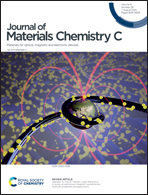Multi-stimuli-responsive luminescent MCM48 hybrid for advanced anti-counterfeiting applications†
Abstract
Two lanthanide complexes supported on MCM48 type silica have been synthetized to introduce a new concept of multi-stimuli responsive materials for anti-counterfeiting applications. This new technology provides a simple and secure way of storing information with different levels of security from biocompatible materials. Different luminescent patterns can be revealed and suppressed by external stimuli: addition and removal of a specific reagent (chemical stimulus) followed by UV exposure to reveal the characteristic luminescence of the material and heat treatment (physical stimulus) to suppress the red luminescence of the material. The chemical stimulus occurs from the complexation of β-diketone 4,4,4-trifluoro-1-phenyl-1,3-butadione (BTFA) in the Eu(H2O)nL–SiO2 (L = chelidamic acid or trimesic acid) printed hybrid and can be made via insertion of the ligand by soaking the label using a marker pen. Physical stimuli can occur through a portable heat gun. The complexation with BTFA enhances the Eu-luminescence through the antenna effect under exposure to common UV-light. Heating (∼145 °C) for a few seconds rapidly quenches the luminescence of the label and, after some cycles of heating–cooling, BTFA sublimates and leads to complete quenching of the red luminescence. The combination of chemical and physical stimuli provides two levels of security verification and unbreakable encryption.



 Please wait while we load your content...
Please wait while we load your content...